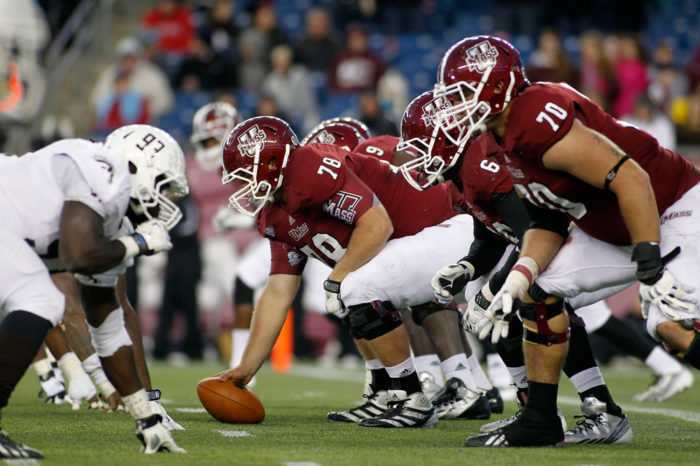UMass Amherst Athletics’ Spending: Costing the Taxpayer Money
College sports have long been a major and growing attraction at universities across the country. Their rising prominence on campuses nationwide, however, has not come without costs. As their popularity has grown, college sports have taken on a business-like culture. Athletic departments often look and act more like businesses than amateur athletics programs, with television contracts, brand sponsorships, and facilities aimed at attracting better recruits, appealing to alumni donors and exposing the school’s brand to a wider audience. Even at a school like UMass Amherst, which may not be as competitive as top-ranked peers, these costs can add up.
From fiscal year 2004 to fiscal 2009, UMass Amherst had 23 varsity teams, but since FY2010 the school has slimmed down to 21 teams. According to USA Today, of all public universities fielding NCAA Division I programs in 2015, UMass Amherst ranked 71st out of 231 programs in total revenue, generating about $36.5 million while spending almost $36.9 million on athletics over 2015. The same USA Today data highlights that $28.6 million, or 78.55 percent, of the school’s revenue was subsidized by the state. This data directly matches internal documents gathered through Freedom of Information Act (FOIA) requests, and helps to highlight a trend.
The revenues and expenses of UMass Amherst’s athletics department are steadily climbing upward. Absent from the public conversation on this trend, however, is the fact that UMass Amherst’s athletics department has run a deficit in six of the past twelve years. Over the course of this timeframe, the total amount of state funding has increased. In FY2004, while total operating revenue was equal to $18.013 million, $5.269 million came from so-called “Direct State or Other Government Support”—or government money that had been earmarked for athletics—and $1.607 million in “Direct Institutional Support”, which is money that the institution decides to spend on athletics. It is important to stress that both of these budget items were taxpayer-funded: one was direct support to UMass Amherst’s athletics program, while the rest of the funding was allocated from general appropriations from the state.
After FY2005, UMass Amherst Athletics no longer received any direct state funding, but saw the amount it received as direct institutional support soar to $16.762 million in FY2015, when its total revenue was $36.512 million, with the $16.762 million in direct institutional support being the single largest revenue item.
This nearly $17 million also comes on top of the $8.151 million that the university received from student fees in FY2015 to fund athletics—a bump up from the FY2004 total of $6.662 million. These are mandatory fees that students have to pay to the university as part of their total cost of attendance. Meanwhile, ticket sales constituted a measly $1.643 million in FY2015.
An additional factor to consider here is that, after UMass Amherst’s decision to leave the Mid-American Conference (MAC), the university should expect to lose some of the $2.092 million that it received in NCAA Conference Contributions in FY2015. After earning $235,000 in broadcasting, television, and radio rights in FY2004, since then the school has only raised a combined $33,000 in subsequent years. UMass earned no revenue from this budget item during fiscal years 2005, 2006, 2007, and 2015.
Another subsidy that the athletic department receives, listed as operating revenue, is indirect institutional support (or “Indirect Facilities and Administrative Support” as it was previously recorded as)—this subsidy totaled $3.768 million in FY2015. This comes after the athletics department did not receive anything from this budget item from FY2004 to FY2007, but suddenly received funding to the tune of $2.5 million beginning in FY2008. Indirect institutional support is the “input value of costs covered and services provided by the institution to athletics, but not charged to athletics”. Items in this spending area include facility debt service and maintenance, security, and administrative services. With this allocation, UMass athletics essentially gets to use facilities that it does not have to pay for with its own revenue or money budgeted towards it otherwise. One has to consider here that taxpayers and students might be left on the hook in paying for a program that cannot generate revenue based on its teams’ performances given the fact that UMass Amherst as a public school receives a significant portion of its funding from the Commonwealth.
There are also items on the expense side that should raise eyebrows. In FY2004, UMass Amherst reported spending no money at all on medical expenses or medical insurance for its student-athletes, but since that time has seen the same budget item total $350 thousand and above eight times, including three years when it ran over $400 thousand. In addition, from FY2004 to FY2015, the amount of student-athlete financial aid has doubled from $4.194 million to $9.468 million, even though the total number of programs the university fields has decreased.
Can these increases be explained by UMass’ moving up from the Football Championship Subdivision (FCS) to the Football Bowl Subdivision (FBS)? In FY2012, the school’s last year in FCS, it spent $7.637 million in student-athlete aid, and in FY2013, its first year in FBS, it spent $8.523 million. This pales in comparison to the increase from FY2011 to FY2012, when student-athlete aid increased from $6.633 million to $7.637 million. Also, after spending no money on Indirect Facilities and Administrative Support (also known as Indirect Institutional Support) from FY2004 to FY2007, UMass paid $3.768 million in FY2015 alone. Basically, UMass Amherst’s athletics department recorded the full amount of Indirect Institutional Support it received both as a revenue and expenditure source even though one completely negates the other.
UMass Amherst students and families, along with taxpayers, should be aware that the cost of publicly-funded athletic programs are going up. While college sports help to create school community and boost the pride of student and alumni groups, UMass administrators would be wise to find a way to sell more tickets to students and alumni and develop other, creative revenue mechanisms besides state subsidies.



